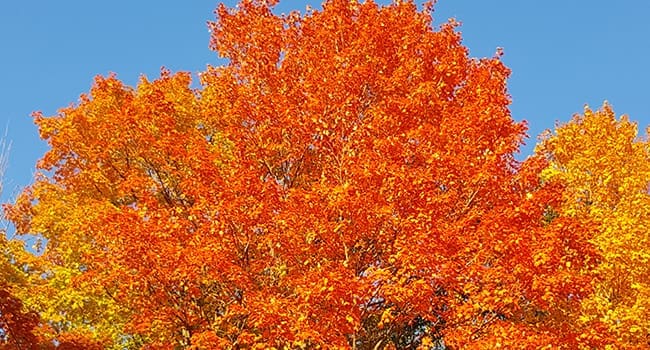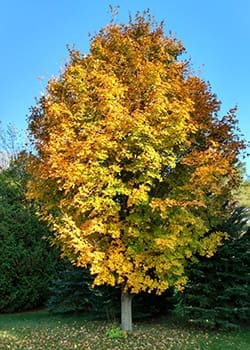
Fall colours are there all the time but are masked by chlorophyll, the green pigment most plants have that’s used to produce their food
 We’re fortunate to live in a place and a climate where our four seasons are distinct. Enough natural foliage persists for us to see and admire broad palettes of colour in September, October and even early November.
We’re fortunate to live in a place and a climate where our four seasons are distinct. Enough natural foliage persists for us to see and admire broad palettes of colour in September, October and even early November.
Although foreshadowing the onset of winter, hues of orange, red, yellow and brown intermingle with shades of green. It happens every year but we still watch in awe as the trees change colour and the leaves eventually fall.
But what’s really going on here? Why do plants even go to all this trouble?
Let’s answer the second question first. Plants are full of water, a medium that’s critical to the survival of the trees as fluids carry food through the plant and help flush waste from them. Water freezes in winter, so food transport becomes impossible as the veins in the plants become clogged with ice crystals. That’s a bit simplistic but it captures the essence of why it’s better not to make food in January if you’re a tree.
So how do all the green leaves change colour?
Although this is up for discussion in some circles, surprisingly they don’t!
The fall colours are there all the time but are masked by chlorophyll, the green pigment most plants have that’s used to produce their food. In the fall, chlorophyll production gradually declines and eventually stops entirely.
At this point, the green of the leaves fades and the underlying colours emerge. Shades of red, orange and yellow predominate and are derived from different pigments. Carotenoids produce the orange, xanthophyll the yellow and tannins the brown colours, while anthocyanins produce the reds and purples.

Plants are full of water, critical to the survival of the trees as fluids carry food through the plant and help flush waste from them
The lengthening night seems to be the overriding factor that stimulates trees to change colour, as the trees react to changing biological processes in the leaves.
Now a mystery does persist – why are some trees red, others brown, and still others yellow or orange?
It’s not really clear and it may have something to do with the type and quantity of sugars produced in the leaves, or how much pigment and in what combination it exists in the leaves in the fall. Suffice to say, it’s complicated.
But the outcome is clearly gorgeous, whatever the reason.
The intensity of the colours that develop in any particular year is related to weather conditions before and during the time the chlorophyll in the leaves is declining, with temperature and moisture the main influences.
A succession of warm, sunny days and cool, crisp (but not freezing) nights seems to bring about the most spectacular displays. Under these conditions, high volumes of sugars are produced in the leaves, but the gradual closing of the leaf’s veins traps these sugars in the leaves. These conditions encourage the production of anthocyanin, which tints the leaves with the more brilliant red, crimson and bright orange colours.
In conditions where we don’t have sunny days mixed with cool nights, the anthocyanins aren’t produced at the same rate and the ever-present yellows and browns persist.
In many parts of Canada, this seems like one of those good autumns, where the colours are intense and unforgettable.
So why don’t evergreens (conifers) lose their leaves?
They do – just not in the same way deciduous trees do. Essentially, conifers’ leaves are tougher than their deciduous cousins and often have a waxy surface that allows them to continue to function throughout the year and not become damaged by freezing and thawing during the long dormant periods of winter.
Most do lose their leaves but gradually, and over a period of months or years. Some species like the white pine drop masses of needles in September, usually from the inner branches. Other species, like the larch, lose all their needles and go dormant like deciduous trees later in the season.
Natural processes are complicated but fascinating. So as we look out on our landscapes, we bid farewell to summer’s beauty and welcome the spectacle of fall colours.
Geoff Carpentier is a published author, expedition guide and environmental consultant. Visit Geoff online at www.avocetnatureservices.com, on LinkedIn and on Facebook.
The views, opinions and positions expressed by columnists and contributors are the author’s alone. They do not inherently or expressly reflect the views, opinions and/or positions of our publication.
